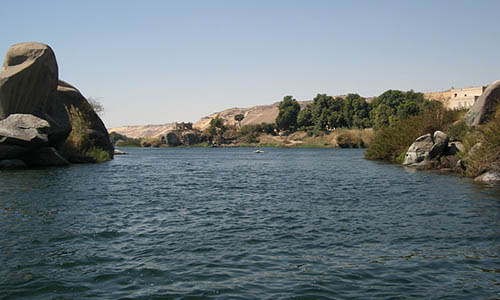The River Nile is arguably the best known river in the world. It flows through the Northern half of the continent of Africa. Its many unique features have made it the nucleus of modern civilization. It is referred to in ancient religious texts and ancient literature. The mystery of its source has attracted explorers from all over the world, through the centuries.
In Arabic the river is called Nahr Al-Nil. The Ancient Egyptians called it and the land around it Aur, for the black sediments it deposited. The Greek Poet Homer (7BCE) referred the river as Aigyptos, giving it the male gender. He called the land by the same name, with a female gender.
FACT 1: The River Nile is the longest river in the world. It originates south of the Equator and empties into the Mediterranean Sea, covering a distance of 6,650 km has various sources but the most distant source is the Kagera River in Burundi.
FACT 2: The Nile is usually associated with Egypt. But only 22% of the river flows through Egypt. The Nile basin drains one tenth of the African continent covering an area of 3,349,000 square km. It irrigates ten African countries; Tanzania, Burundi, Rwanda, the Democratic Republic of Congo, Kenya, Uganda, South Sudan, Sudan, Ethiopia and Egypt.
FACT 3: It is the only river to flow from south to north. This phenomenon was inexplicable to the Ancient Egyptians and Greeks who developed their civilizations along its banks.
FACT 4: The Nile’s unusual habit of flooding its banks at the warmest time of the year was another mystery to the Egyptians and Greeks. This flooding makes the plains on the banks of the Nile extremely fertile. The flooding is caused by very heavy summer rainfall in the Ethiopian Highlands.
FACT 5: When the Nile floods, it deposits black alluvial sediment along its banks. This sediment comes down the Nile all the way from the Ethiopian Plateau. Intense cultivation is possible on these flooded plains.
FACT 6: The Egyptian basin of the Nile is referred to as the cradle of civilization. Agriculture and the use of the plough started here. Ancient Egyptians also practiced the earliest known irrigation techniques. They built dams on the plains to hold the flood waters. Once the land was thoroughly soaked the released the excess water back into the river. The papyrus reed that grew along the banks was used by the Egyptians to make paper.
FACT 7: The awesome Nile crocodile once infested the rivers waters and is credited with bringing down zebra and wildebeest. It is also known as a vicious man eater and approximately 200 humans a year are devoured by the Nile crocodile. They were hunted almost to extinction for their prized hides, but protection has saved them.
FACT 8: Egypt is a desert. The only green area in Egypt is the area around the Nile. All Egypt’s food comes from here. The Aswan Dam was built across the Nile in the 1960’s. This dam has controlled the floods and stabilized the quantity of water brought into Egypt. The dam has brought electricity and water for irrigation and drinking to Egypt. However the dam has altered marine life in the river. Migratory species of fish disappeared as the dam blocked their natural migratory routes.
FACT 9: The Pharaohs of Ancient Egypt lived along the River Nile and bathed in its waters. The leader of the enslaved Israelites, Moses, was adopted the daughter of the Pharaoh. She found the baby Moses in a basket floating on the Nile.
FACT 10: David Livingstone, a famous Scottish explorer set out in 1866 to find the source of the River Nile. The famous phrase ‘Dr Livingstone, I presume’ was uttered by explorer journalist Henry Stanley, when he found Livingstone near Lake Tanganyika. Dr Livingstone continued his search until his death in 1873.









Leave a Reply